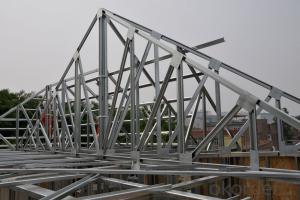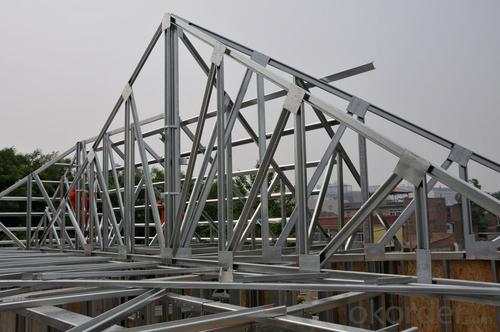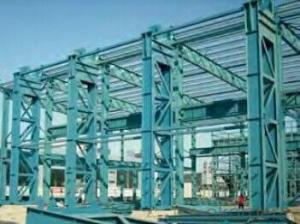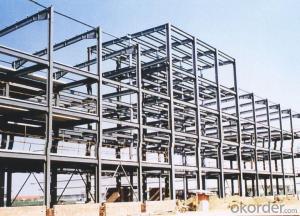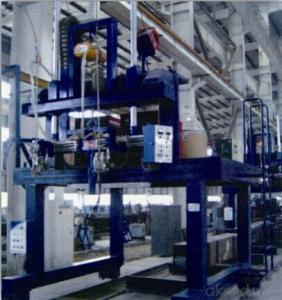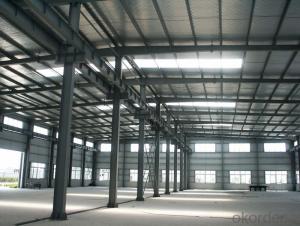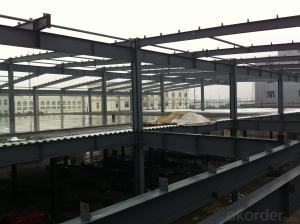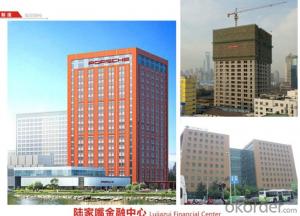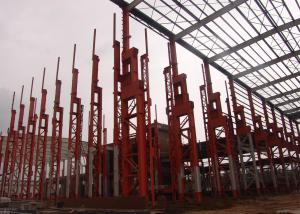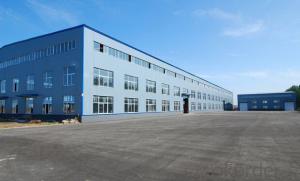High Quality Light Steel Structure
- Loading Port:
- China Main Port
- Payment Terms:
- TT OR LC
- Min Order Qty:
- -
- Supply Capability:
- -
OKorder Service Pledge
OKorder Financial Service
You Might Also Like
Specifications of light steel structure workshop
The steel dosage: 1275MTs
Building area: 12500M2
The unit component weight: 11.4MTs
The span: 24m
1. GB standard material
2. High Structural safety and reliability
3. The production can reach GB/JIS/ISO/ASME standard
Characters of Structure Steel
1. Steel is characterized by high strength, light weight, good rigidity, strong deformation capacity, so it is suitable for construction of large-span, super high and super-heavy buildings particularly;
2. It with good homogeneous and isotropic, is an ideal elastomer which perfectly fits the application of general engineering;
3. The material has good ductility and toughness, so it can have large deformation and it can well withstand dynamic loads;
4. Steel structure’s construction period is short;
5. Steel structure has high degree of industrialization and can realize-specialized production with high level of mechanization.
Packaging & Delivery of light steel structure workshop
1. According to the project design and the component size, usually the main component parts are nude packing and shipped by bulk vessel. And the small parts are packed in box or suitable packages and shipped by containers.
2. This will be communicated and negotiated with buyer according to the design.
Engineering Design Software of light steel structure workshop
Tekla Structure \ AUTO CAD \ PKPM software etc
⊙Complex spatial structure project detailed design
⊙Construct 3D-model and structure analysis. ensure the accuracy of the workshop drawings
⊙Steel structure detail ,project management, automatic Shop Drawing, BOM table automatic generation system.
⊙Control the whole structure design process, we can obtain higher efficiency and better results
*If you would like to get our price, please inform us the specification and details. Thank you very much for your attention.
- Q: What does nonstandard steel structure mean?
- Non standard equipment is non standard equipment, non-standard equipment is compared with standard equipment (GB, HG, JB and so on national or industry standards) in terms of not in accordance with the unified national industry standards and specifications for manufacturing equipment, but according to their own need to use their own design and manufacture of the equipment. Equipment whose appearance or performance is not in the catalogue of national equipment products.
- Q: Can steel structures be dismantled and relocated?
- Yes, steel structures can be dismantled and relocated. Steel is a highly durable and versatile material that can be disassembled and reassembled at a different location without losing its structural integrity. This makes steel structures an excellent choice for temporary or portable buildings, as well as for projects that require flexibility or future expansion.
- Q: How is steel used in industrial structures?
- Steel is widely used in industrial structures due to its exceptional strength, durability, and versatility. It is a primary material used in the construction of various industrial buildings, such as factories, warehouses, power plants, and refineries. One of the key reasons steel is preferred in industrial structures is its strength-to-weight ratio. Steel has a high tensile strength, allowing it to withstand heavy loads and stresses. This makes it suitable for constructing large, open spaces and supporting heavy machinery and equipment. Additionally, steel's durability and resistance to corrosion make it ideal for industrial environments. Industrial structures often face harsh conditions, including extreme temperatures, humidity, and chemical exposure. Steel's inherent resistance to rust and deterioration ensures the longevity and structural integrity of the building. Another advantage of steel is its versatility in design. Steel can be easily molded and fabricated into various shapes and sizes, allowing for flexible and efficient construction. It can be used in the form of beams, columns, trusses, and frames, providing structural stability and support. Furthermore, steel is a sustainable choice for industrial structures. It is a recyclable material, reducing waste and minimizing environmental impact. The use of recycled steel in construction also helps conserve natural resources. Overall, steel is an essential component in industrial structures due to its strength, durability, versatility, and sustainability. Its unmatched properties make it a reliable and cost-effective choice for constructing safe and robust industrial buildings that can withstand the demands of modern industries.
- Q: What are the design considerations for steel structures in transportation or infrastructure projects?
- There are several key design considerations for steel structures in transportation or infrastructure projects. One important factor is the structural strength and durability of the steel, ensuring it can withstand heavy loads, vibrations, and environmental conditions. Another consideration is the safety of the structure, including measures to prevent collapse or failure during extreme events such as earthquakes or hurricanes. Additionally, the design should take into account factors such as cost-effectiveness, feasibility, and constructability, ensuring efficient and practical implementation. The aesthetics and integration of the steel structure within the surrounding environment are also important considerations for transportation or infrastructure projects. Overall, the design of steel structures in these projects requires careful attention to various technical, safety, and aesthetic aspects to ensure their success.
- Q: How are steel structures demolished at the end of their lifespan?
- Controlled demolition is the typical method used to demolish steel structures when they reach the end of their lifespan. This process ensures the safe and efficient dismantling of the structure while minimizing any potential hazards or damage to the surrounding environment. To start the demolition of a steel structure, a thorough assessment and planning phase is conducted. This includes evaluating the condition of the structure, identifying any possible risks or hazards, and developing a demolition plan that outlines the necessary steps and precautions to be taken. Once the plan is finalized, the demolition process begins by removing any hazardous materials, such as asbestos or lead, that might be present in the structure. This is done in strict compliance with safety regulations to protect the workers and the environment. Following the removal of hazardous materials, the steel structure is dismantled piece by piece, starting from the top and working downwards. Heavy machinery, like cranes or excavators, is often employed to assist in this process. Careful cutting and removal of steel beams and columns are carried out to ensure the stability of the structure and prevent premature collapse. During the demolition, measures are taken to control dust, noise, and vibrations, minimizing disturbances in the surrounding area. Water sprays or dust suppression systems are frequently used to keep dust levels low, while noise barriers or mufflers are installed on machinery to reduce noise pollution. Once the steel structure has been fully dismantled, the debris is sorted and separated for recycling or disposal. Steel, being a highly recyclable material, is often salvaged and sent to recycling facilities where it is melted down and used in the production of new steel products. In conclusion, steel structures are demolished at the end of their lifespan through a controlled demolition process that involves meticulous planning, removal of hazardous materials, systematic dismantling, and responsible disposal or recycling of the debris. This approach ensures the safe and efficient demolition with minimal impact on the environment.
- Q: How are steel structures designed for mezzanine floors?
- Steel structures for mezzanine floors are typically designed using engineering principles and calculations to ensure they can safely support the desired load capacity. Factors such as the weight of the mezzanine, the intended use of the space, and any additional loads that will be placed on the structure are considered during the design process. The design will also take into account local building codes and regulations to ensure compliance and safety.
- Q: How are steel structures designed to be flexible and adaptable?
- Steel structures are designed to be flexible and adaptable through a combination of careful material selection, engineering techniques, and design principles. Firstly, the use of steel as a construction material provides inherent flexibility due to its high strength-to-weight ratio and ductility. This allows for the creation of slender and lightweight structures that can withstand various loads and stresses. Additionally, steel structures can be designed with modular components, allowing for easy modification, expansion, or reconfiguration as needed. The use of bolted connections instead of welded ones further enhances adaptability by facilitating easier disassembly and reassembly. Overall, the design of steel structures emphasizes flexibility and adaptability to accommodate future changes or requirements effectively.
- Q: How are steel structures designed for efficient use of renewable energy sources?
- There are several ways in which steel structures can be designed to effectively utilize renewable energy sources. Firstly, solar panels can be integrated into the structure's design, either on the roof or walls. These panels can capture sunlight and convert it into electricity, which can be used to power the building or be fed back into the grid. By incorporating solar panels, the building can generate clean and sustainable energy, reducing its reliance on fossil fuels. Moreover, steel structures can be designed to optimize natural lighting and ventilation. Strategically placed large windows and skylights allow for ample natural light, decreasing the need for artificial lighting during the day. This not only saves energy but also creates a pleasant and productive indoor environment. In terms of ventilation, steel structures can be designed with features such as operable windows or louvers that facilitate natural airflow. This promotes natural cooling and reduces the necessity for air conditioning, especially in moderate climates. By leveraging natural ventilation, the building can minimize its energy consumption and dependence on mechanical cooling systems. Another method to efficiently utilize renewable energy sources in steel structures is by integrating wind turbines. These turbines can be installed on the roof or adjacent to the building, harnessing the power of wind to generate electricity. Vertical axis wind turbines are particularly suitable for urban environments and can be easily incorporated into the design of steel structures. Finally, steel structures can also be designed to capture and reuse rainwater. By integrating rainwater harvesting systems into the building's design, rainwater can be collected and stored for non-potable uses such as irrigation or toilet flushing. This reduces the demand for freshwater and conserves water resources. In conclusion, steel structures can be designed in various ways to effectively utilize renewable energy sources. By incorporating solar panels, maximizing natural lighting and ventilation, integrating wind turbines, and implementing rainwater harvesting systems, these structures can significantly reduce their carbon footprint and contribute to a more sustainable and environmentally friendly built environment.
- Q: How are steel structures used in the construction of warehouses?
- Steel structures are commonly used in the construction of warehouses due to their strength, durability, and flexibility. They provide a sturdy framework that can support heavy loads and withstand harsh weather conditions. Steel beams and columns are used to create the skeleton of the warehouse, providing stability and allowing for large open spaces without the need for interior support walls. Additionally, steel structures can be easily customized and modified, allowing for future expansion or alterations to the warehouse layout.
- Q: How are steel structures designed and constructed to meet sustainability goals?
- Steel structures are designed and constructed to meet sustainability goals through various methods. Firstly, the steel used in these structures is often made from recycled materials, reducing the demand for virgin resources. Additionally, the design of steel structures focuses on maximizing energy efficiency, with features such as proper insulation and use of natural lighting. Steel structures also have a long lifespan and are highly durable, reducing the need for frequent repairs or replacements. Finally, at the end of their life cycle, steel structures can be easily dismantled and recycled, minimizing waste and contributing to a circular economy.
Send your message to us
High Quality Light Steel Structure
- Loading Port:
- China Main Port
- Payment Terms:
- TT OR LC
- Min Order Qty:
- -
- Supply Capability:
- -
OKorder Service Pledge
OKorder Financial Service
Similar products
Hot products
Hot Searches
Related keywords
